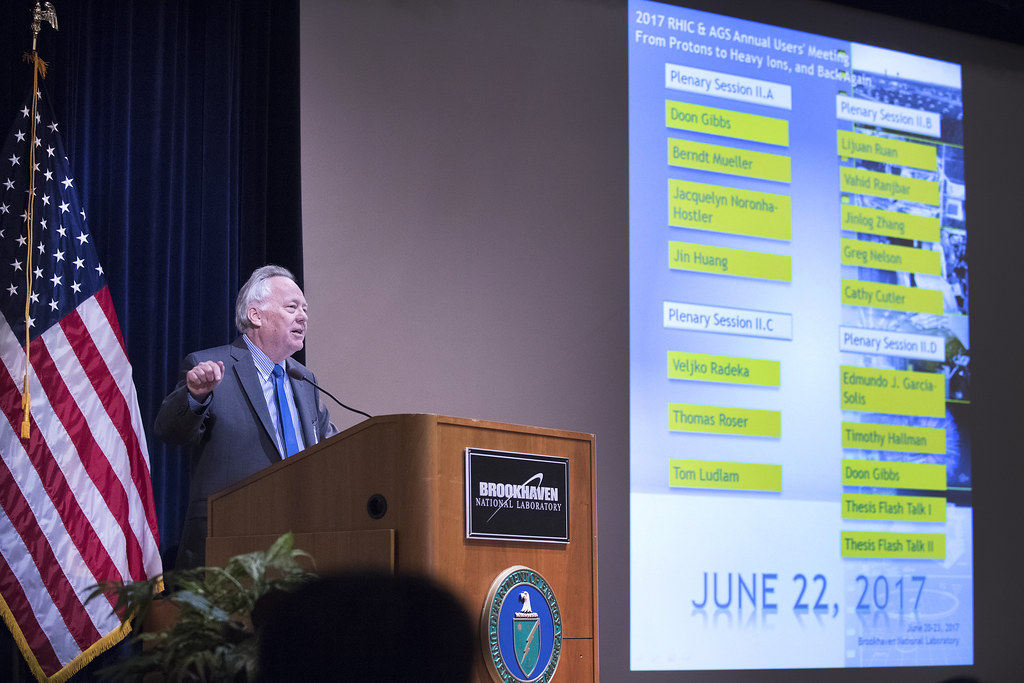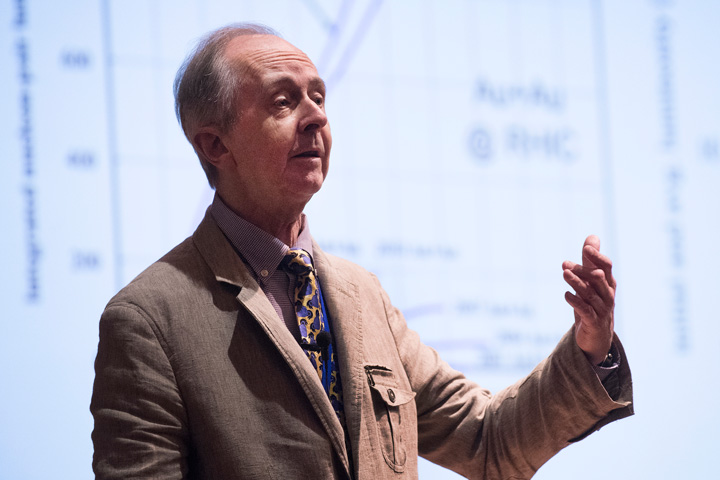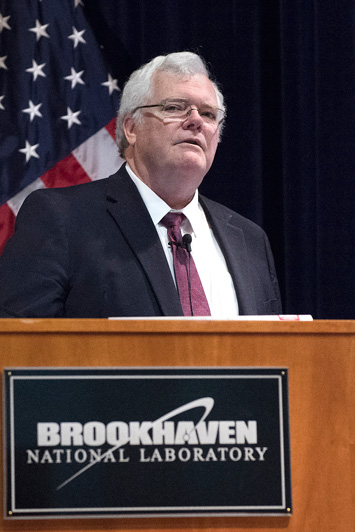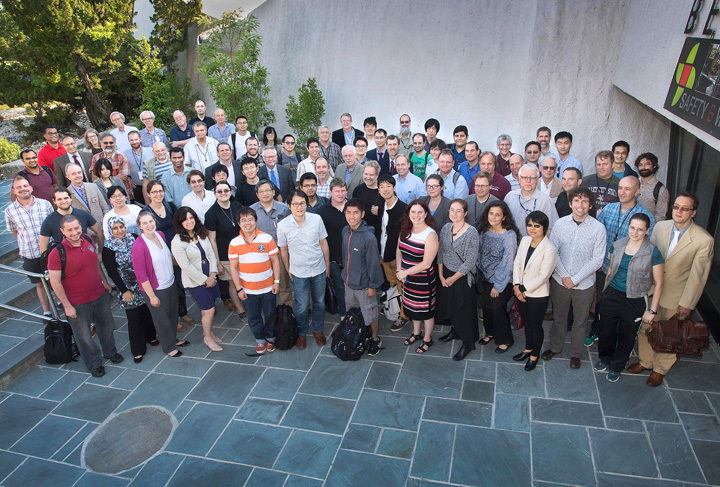2017 RHIC & AGS Annual Users' Meeting: From Protons to Heavy Ions, and Back Again
July 12, 2017
Scientists conducting research at the Relativistic Heavy Ion Collider (RHIC) and Alternating Gradient Synchrotron (AGS)—flagships in the collider-accelerator complex at the U.S. Department of Energy’s (DOE) Brookhaven National Laboratory—gathered to discuss highlights of nuclear physics research and related topics, as well as plans for the future, at the annual RHIC & AGS Users’ Meeting, June 20-23. A full day of workshops preceded three days of plenary sessions punctuated by opportunities for networking and social interaction among the nearly 200 attendees, who came to Brookhaven from 21 U.S. states and 9 other nations.
At the main plenary session on Thursday, June 22, Brookhaven Lab Director Doon Gibbs emphasized the importance of the meeting as “a chance to tell you what’s going on at the Lab and for you to tell us what’s going on with you.” Recognizing the uncertainty surrounding the proposed budget for Fiscal Year 2018 (FY18), he encouraged attendees to speak with representatives of DOE and the National Science Foundation (NSF), the federal funding agencies that support research at RHIC and the AGS-linked facilities, who would be presenting their approaches to the uncertain budget picture later in the day.

Brookhaven Lab Director Doon Gibbs led off the meeting's plenary session on Thursday, June 22. Click the photo to scroll through a slide show of other images from the meeting.
Gibbs also made note of the Lab’s 70th anniversary and the 100th anniversary of Camp Upton, the former U.S. Army induction and training site on which the Lab was developed—and where Irving Berlin penned the famous tune, “God Bless America.” The meeting, he said, would honor the past with a series of talks on the history of particle accelerators and detectors—given by Veljko Radeka of Instrumentation; Thomas Roser, Chair of the Collider-Accelerator Department; and Tom Ludlam of Physics. There would also be considerable focus on the future with a series of talks on a proposed future Electron-Ion Collider (EIC), as well as a fact sheet that is now open to comments from the community, Gibbs said.
“This fact sheet was developed in collaboration with Jefferson Lab and also handed out at their user meeting this week,” Gibbs said, as he invited users to send feedback to EICcommunications@BNL.gov.
Gibbs also made note of another encouraging development for the future: a $20 million investment by New York State in a plan that includes moving the Long Island Rail Road Yaphank train station considerably closer to the Lab. By simplifying travel to and from New York City and area airports, this improvement would be “a game changer for the Laboratory and all of its users.”
Celebrating success
Berndt Mueller, Brookhaven’s Associate Laboratory Director for Nuclear & Particle Physics, then gave an overview of progress toward executing the highest priority research outlined in the Nuclear Science Advisory Committee’s 2015 Long Range Plan.
 enlarge
enlarge
Berndt Mueller, Brookhaven's Associate Laboratory Director for Nuclear and Particle Physics, presented highlights and plans for the future.
“There is a lot you can be proud of for having already achieved,” he said, highlighting the unique capabilities of RHIC for exploring the various phases of “QCD” matter—that is, matter made up of quarks and gluons, the fundamental building blocks of atomic nuclei, whose interactions are described by a theory known as “quantum chromodynamics.”
RHIC, a DOE Office of Science User Facility, was designed to collide beams of a range of different nuclei to “free” these building blocks, forming a quark-gluon plasma (QGP) that mimics the matter that existed in the early universe, before protons, neutrons, and the nuclei of atoms formed. It is also the only collider in the world that can control the spin, or intrinsic magnetism, of colliding protons to explore how the quark and gluon building blocks contribute to proton spin.
“If you need a collision condition, RHIC can create it,” he said, recapping how recent experiments have included collisions of different types of nuclei over a wide range of energies with record-breaking numbers of collisions.
“RHIC is now operating at 44 times the design luminosity,” he said, using a reference to a beam characteristic that drives collision rates. “That’s absolutely staggering. In 10 minutes RHIC today produces more collisions than during the entire commissioning run in 2000,” he said. Future plans to “cool” the beams so even more particles collide will likely continue to break these records, yielding even more data for fruitful physics discoveries.
Highlights and future plans
Mueller went on to present highlights of some of the discoveries to date, including descriptions of how “heavy” quarks get caught up in the flow of QGP, even in collisions of small particles with larger nuclei and even at low energy. These findings help confirm the “perfect liquid” nature of the QGP, a substance in which the constituent particles interact strongly but flow like a liquid with almost no resistance.
He also described efforts to characterize the gluon distribution around the quarks that make up protons, and unexpected discoveries such as the “vorticity,” or swirliness, of the QGP. The latter may point the way to measuring the strength of the magnetic field produced in RHIC collisions, which manifests by separating particles with different charges.
Measurements of particle production that depend on protons’ spin alignment hint at ways to use spin as a tool for exploring the internal structure of protons and nuclei.
“This is crucial science to underpin the physics at an electron-ion collider. If we understand how spin works, we can use it as a tool to explore QCD at an EIC,” Mueller said.
For the more immediate future, the goals include collisions using different “isobars”—atoms of different elements that have the same atomic weight, but different numbers of protons, and therefore different degrees of positive charge. These experiments would vary the strength of the magnetic field generated in collisions so physicists can test its effect on charge separation and relationship to key characteristics of QGP.
They’ll also continue testing new beam-cooling techniques and install an “inner Time Projection Chamber” (iTPC) upgrade to the STAR detector—the latter made possible by large international contributions and participation that are very important to recognize, Mueller said.
Both the iTPC and cooling techniques are essential to a continuing search for a “critical point” in the transition of “free” quarks and gluons to protons and neutrons, as part of STAR’s Beam Energy Scan II. New “fixed target” experiments—colliding one of RHIC’s beams with a stationary target—will also be essential to this effort, giving access to the lowest energy ranges in the nuclear phase diagram.
As for RHIC’s other large detector, PHENIX, it is poised to undergo a radical transformation to sPHENIX, which will have a solid five-year physics program, Mueller said.
When complete, sPHENIX will be able to track particle “jets” created in half a trillion events in a year. This data, complementary to that from heavy-ion experiments at Europe’s Large Hadron Collider (LHC), will enable an unprecedented look at the microscopic structure of the QGP, and how its fluidity emerges from that structure.
Mueller concluded by encouraging attendees to avail themselves of the opportunities to continue to discuss the details of what he called “the RICH opportunities of RHIC!”
An abundance of details

Of particular note is an effort to build an ongoing workforce to continue analyzing PHENIX data that is stored on tape. More than 30 participants, mostly Ph.D. students, attended a three-day workshop earlier this year, eager to contribute to analyses and publications that will have scientific impact for years to come.
There was also a report on Run 17 machine performance, which included innovative accelerator techniques for maintaining the spin polarization of protons and steady levels of high luminosity. A presentation of new data logged by STAR detailed its first run as RHIC’s sole detector until sPHENIX comes online.
STAR collaboration spokesperson Zhangbu Xu expressed gratitude to the collider-accelerator team, noting that the experiment had surpassed its target goals for data collection by more than 30 percent thanks to the “excellent run.”
These talks were followed by overviews of the NASA Space Radiation Laboratory (NSRL) and Brookhaven’s Medical Isotope Research and Production Program. These programs are often called symbiotic with the research at RHIC because they make use of the same beams and accelerator-physicist expertise that drive the RHIC/AGS accelerator complex. Though they serve vital national needs—exploring the risks future astronauts will face during long-terms space missions and producing certain critical isotopes used to diagnose and treat disease—the infrastructure that makes them possible would be prohibitively expensive to maintain without funding for the physics program.
A hint of the history
The idea of symbiosis—this time between the fields of nuclear and particle physics—continued in the talks recounting the history of particle detectors and accelerators. A common theme was Brookhaven Lab as a birthplace of many innovative technologies that have benefitted these two fields—as well as many other areas of science.
“BNL has a 70-year history and a bright future at the forefront of accelerator science and technology in support of the research needs of the nation with many applications for society,” Thomas Roser said.
Indeed, the fact that RHIC is now leading the exploration of the QCD phase diagram—which was just a cartoon at the time the idea of RHIC was first conceived—“has come about through pushing the limits of accelerator and detector technology,” said Tom Ludlam. “This has led to a unique nuclear physics facility developed on the shoulders of high energy physics,” with discoveries that are of interest to a broad community and that “set the stage for the future EIC.”
Funding for the future
Representatives of NSF and DOE then discussed funding for that future, focused primarily on the near term impacts of the budget request currently under consideration in Congress.
Edmundo J Garcia-Solis, Program Director for Experimental Nuclear Physics and Mathematical and Physical Sciences at NSF, noted that the goal of his program is to “identify research opportunities and the most compelling physics through the peer review process and support [as much of that] as possible while managing a balanced portfolio.” Even with a possible 13 percent reduction in research funding, “our goals and actions remain the same,” he said, noting that the competition for more limited funds will certainly be harder.
He noted several specific funding opportunities, including single investigator projects with strong educational components, career opportunities, and funding for both the development and acquisition of major and midscale instrumentation.
 enlarge
enlarge
Timothy Hallman, Associate Director of Science for Nuclear Physics at the DOE Office of Science, discussed the budget for nuclear physics.
Specific possible impacts for Brookhaven include a RHIC run reduced to 10 weeks to be combined with the following year’s run; no new funding for the spin physics program at RHIC or the heavy-ion research program at the LHC; a hold on early career research awards; no capital equipment, accelerator improvement project, or facility accelerator R&D funding for RHIC; no start of funding for the sPHENIX upgrade beyond the pre-conceptual design and R&D already underway; and a loss of about 100 jobs.
He emphasized that these proposed cuts were in no way a reflection on the quality of the research at RHIC, repeatedly pointing out the program’s enormous and ongoing success.
“I want to bring home the fact that these impacts are in all areas of nuclear science; everyone is sharing in them,” he said, describing similar proposed cuts to research at Jefferson Lab and in other parts of the nuclear physics program, including a general reduction, beyond the specific cuts, of 24.5 percent across all research lines.
And he noted that final funding levels may not be known for a while as both houses of Congress would still weigh in with their proposed budgets, and that both houses and the executive branch would have to come to agreement.*
Meanwhile, “We have to stay focused… We can’t afford to forget to do what we are good at,” he said—namely, delivering exciting discoveries and important scientific knowledge and technological advances for the nation.
Both Hallman and Garcia-Solis recognized the importance of trying to protect students, who represent the future of the field but may be discouraged by the budget uncertainty.
“I would like to enjoin all of you who have been in the field to try to put some perspective on this for the young people. It is a process … Let’s keep focused and see how this works out,” Hallman said.
Upgrades and EIC
Friday’s talks took Hallman’s positive, “business as usual” approach, with presentations describing details of upgrades to STAR and sPHENIX, Brookhaven’s proposed accelerator design for an Electron-Ion Collider (known as eRHIC), the science goals of an EIC, and an overview of the National Academy of Sciences EIC review process.
eRHIC would make use of many components of RHIC, including one of the existing heavy ion accelerator rings, and fit within the RHIC tunnel, said Ferdinand Willeke, who is leading the design development for Brookhaven. The idea is to add an electron storage ring and components to accelerate electrons up to 18 billion electron volts (GeV) for collisions with protons and heavy ions. He described efforts currently underway to explore different acceleration and beam cooling options to meet the energy and luminosity needed for the proposed research.
“Designing a densely populated area with magnet and detector parts is an art. So far we have a solution that seems to satisfy all of the requirements,” he said.
Brookhaven physicist Salvatore Fazio’s presentation on EIC science included some details on Jefferson Lab’s proposed design, which builds on their existing electron accelerator, the Continuous Electron Beam Accelerator Facility (CEBAF), and adds a hadron accelerator.
Either design, he said, would allow scientists to answer key questions about quarks and gluons, including how their spins are distributed and contribute to overall proton spin, and how the properties of protons and neutrons emerge from the smaller building blocks and their interactions, ultimately resulting in the formation of atomic nuclei.
“We have a very active user group worldwide,” he said, with 692 members, from 157 institutions, 29 countries, and 6 world regions—and growing.
Awards and elections
The meeting also included presentation of thesis awards to Prashanth Shanmuganathan of Kent State University, whose thesis was titled, “First Moment of Azimuthal Anisotropy in Au+Au Collisions from the Beam Energy Scan at the Relativistic Heavy Ion Collider,” and Zilong Chang, Texas A&M University and now on staff at Brookhaven, on “Inclusive Jet Longitudinal Double-Spin Asymmetry in ALL Measurements in 510 GeV Polarized pp Collisions at STAR.” Each gave a flash talk highlighting their work. Alicia Farin-McConnell of Duke University and Malek Haj Tahar of Université Grenoble Alpes, CNRS/IN2P3, earned honorable mention awards for their thesis research on epithelial cells at NSRL and accelerator-driven technologies for nuclear reactors, respectively. Michael Lomnitz of Lawrence Berkeley National Laboratory won the poster award for his work, “D0 Elliptic and Triangular Flow in Au+Au Collisions at RHIC.”
Before the meeting concluded, RHIC-AGS Users’ Executive Committee (UEC) Chair Lijuan Ruan of Brookhaven National Laboratory announced the UEC election results. Rosi Reed of Lehigh University was voted chair-elect. She is joined by newly elected members Justin Frantz, Ohio University; Jacquelyn Noronha-Hostler, University of Houston; and Tony Frawley, Florida State University. The student/postdoc representatives are James Daniel Brandenburg, Rice University; Alexander Jentch, University of Texas, Austin; and Li Yi, Yale University. The UEC's outgoing members are Agnes Mocsy, Pratt Institute; Christine Nattrass, University of Tennessee; Christina Swinson, Brookhaven National Laboratory; Kathryn Meehan, University of California at Davis; and Timothy Rinn, Iowa State University.
*At the time of publication, the House of Representatives had presented its first markup on the FY18 budget.
Brookhaven National Laboratory is supported by the Office of Science of the U.S. Department of Energy. The Office of Science is the single largest supporter of basic research in the physical sciences in the United States, and is working to address some of the most pressing challenges of our time. For more information, please visit science.energy.gov.
Follow @BrookhavenLab on Twitter or find us on Facebook.
2017-12294 | INT/EXT | Newsroom











